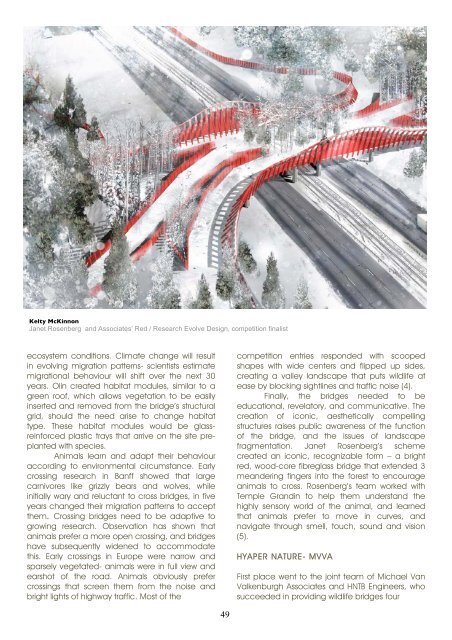Animal Influence I - Antennae The Journal of Nature in Visual Culture
Animal Influence I - Antennae The Journal of Nature in Visual Culture
Animal Influence I - Antennae The Journal of Nature in Visual Culture
Create successful ePaper yourself
Turn your PDF publications into a flip-book with our unique Google optimized e-Paper software.
Kelty McK<strong>in</strong>non<br />
Janet Rosenberg and Associates’ Red / Research Evolve Design, competition f<strong>in</strong>alist<br />
ecosystem conditions. Climate change will result<br />
<strong>in</strong> evolv<strong>in</strong>g migration patterns- scientists estimate<br />
migrational behaviour will shift over the next 30<br />
years. Ol<strong>in</strong> created habitat modules, similar to a<br />
green ro<strong>of</strong>, which allows vegetation to be easily<br />
<strong>in</strong>serted and removed from the bridge’s structural<br />
grid, should the need arise to change habitat<br />
type. <strong>The</strong>se habitat modules would be glassre<strong>in</strong>forced<br />
plastic trays that arrive on the site preplanted<br />
with species.<br />
<strong>Animal</strong>s learn and adapt their behaviour<br />
accord<strong>in</strong>g to environmental circumstance. Early<br />
cross<strong>in</strong>g research <strong>in</strong> Banff showed that large<br />
carnivores like grizzly bears and wolves, while<br />
<strong>in</strong>itially wary and reluctant to cross bridges, <strong>in</strong> five<br />
years changed their migration patterns to accept<br />
them. Cross<strong>in</strong>g bridges need to be adaptive to<br />
grow<strong>in</strong>g research. Observation has shown that<br />
animals prefer a more open cross<strong>in</strong>g, and bridges<br />
have subsequently widened to accommodate<br />
this. Early cross<strong>in</strong>gs <strong>in</strong> Europe were narrow and<br />
sparsely vegetated- animals were <strong>in</strong> full view and<br />
earshot <strong>of</strong> the road. <strong>Animal</strong>s obviously prefer<br />
cross<strong>in</strong>gs that screen them from the noise and<br />
bright lights <strong>of</strong> highway traffic. Most <strong>of</strong> the<br />
49<br />
competition entries responded with scooped<br />
shapes with wide centers and flipped up sides,<br />
creat<strong>in</strong>g a valley landscape that puts wildlife at<br />
ease by block<strong>in</strong>g sightl<strong>in</strong>es and traffic noise (4).<br />
F<strong>in</strong>ally, the bridges needed to be<br />
educational, revelatory, and communicative. <strong>The</strong><br />
creation <strong>of</strong> iconic, aesthetically compell<strong>in</strong>g<br />
structures raises public awareness <strong>of</strong> the function<br />
<strong>of</strong> the bridge, and the issues <strong>of</strong> landscape<br />
fragmentation. Janet Rosenberg’s scheme<br />
created an iconic, recognizable form – a bright<br />
red, wood-core fibreglass bridge that extended 3<br />
meander<strong>in</strong>g f<strong>in</strong>gers <strong>in</strong>to the forest to encourage<br />
animals to cross. Rosenberg’s team worked with<br />
Temple Grand<strong>in</strong> to help them understand the<br />
highly sensory world <strong>of</strong> the animal, and learned<br />
that animals prefer to move <strong>in</strong> curves, and<br />
navigate through smell, touch, sound and vision<br />
(5).<br />
HYAPER NATURE- MVVA<br />
First place went to the jo<strong>in</strong>t team <strong>of</strong> Michael Van<br />
Valkenburgh Associates and HNTB Eng<strong>in</strong>eers, who<br />
succeeded <strong>in</strong> provid<strong>in</strong>g wildlife bridges four












